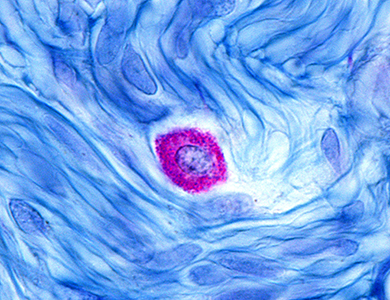DISEASE AREAS
RARE DIEASE SYSTEMIC MASTOCYTOSIS
Systemic Mastocytosis is the rare disease variant of mast cell activation disease (MCAD) featuring inappropriate mast cell activation leading to widespread systemic symptoms that is primarily driven by the constitutively activating KIT816V mutation. The clinical presentation is very diverse and can be devastating including, for example, constitutional, dermatologic, gastrointestinal, neurologic, pulmonary, cardiovascular, musculoskeletal and immunologic symptoms with a high need for more effective treatments. The global prevalence is on average 5 to 13 out of 100.000 resulting in about estimated 750.000 patients globally.
CHRONIC URITCARIA
Chronic spontaneous urticaria (CSU) or inducible urticaria are primarily caused by the inappropriate activation and degranulation of dermal mast cells. Increased numbers of mast cells are found in both lesional and non‐lesional skin in CSU and inducible urticaria. Various activating factors stimulate mast cells to secrete vasoactive molecules, cytokines and neuropeptides that directly and indirectly drive the inflammation leading to increased vasopermeability and extravascular leakage of fluids and proteins leading to chronic urticaria and the related symptoms (e.g. urticarial wheals). The global prevalence for chronic urticarial is estimated at about 1% to 2% with an estimated 70 million patients globally.
Asthma
Increasing evidence points toward a key role of mast cells in the pathogenesis of asthma, in particular airway responsiveness and tissue remodeling, increasing the need to develop effective mast cell targeted therapies. Mast cells play a key role in regulating mucous gland secretion by infiltrating the airway mucous glands in patients with asthma correlating with the amount of mucus obstructing the airway lumen. Further, the close approximation of increased number of activated mast cells within the airway smooth muscle cells leads to disordered smooth muscle function. Patients with asthma are often co-morbid with rhinitis and conjunctivitis with activated mast cells often as common cause enabling a multi-symptom treatment. The global prevalence for asthma is estimated at about 5% to 8% with an estimated 250 million patients globally.
COPD (Chronic Obstructive Pulmonary Disease)
Lung damage as in chronic obstructive pulmonary disease (COPD) is the third leading cause of death worldwide and imposes an enormous socioeconomic burden. Besides providing symptomatic relief, COPD lacks effective treatment due to not yet fully understanding the underlying disease mechanism. Recent advances in the investigation of the pathogenesis of COPD has revealed that activated mast cells resulting in mast degranulation (for example releasing tryptase), the release of cytotoxic mediators and associated immune cell influx promote the inflammatory response, alveolar destruction and emphysema. Targeting activated activated mast cells could be a promising novel treatment to prevent and reduce the severity of COPD disease. The global prevalence for COPD is estimated at about 5% with an estimated amount of more than 200 million patients globally.
NASH (Nonalcoholic Steatohepatitis)
MAST CELL MEDIATOR SYNDROME
Chronic mast activation is commonly triggerd by pathologically altered, constitutively activated mast cells in organs and tissues with constitutive release of mast cell mediators and cytokines. Pathologically permanently activated mast cells don‘t undergo early apoptosis, but further induce a secondary unregulated activation of further mast cells in the organism resulting in a cascading chronic activation and potentially accumulation of mast cells in varying tissues and organs. This resulting permanent mast cell activation in combination with the widespread distribution of mast cells and the heterogeneity of excessive mediator release leads to widespread individual symptoms that can occur in any organs, tissues, systems.
Chronic mast cell activation with excessive mediator release can be the underlying cause for a significant portion of patients diagnosed with one or more of the following chronic diseases:
- MCAS (Mast Cell Activation Syndrome)
- Fibromyalgia
- Interstitial Cystitis
- Irritable Bowel Syndrome (IBS)
- Chronic Lyme
- Long Covid
MC Sciences is planning a basket trial for these chronic diseases targeting constitutively activated mast cells as underlying common cause based on clear patient population identification criteria for mast cell activation. The global prevalence for diseases related to chronic mast cell activation with excessive mediator release is about 10% with an estimated 500 million patients globally.






